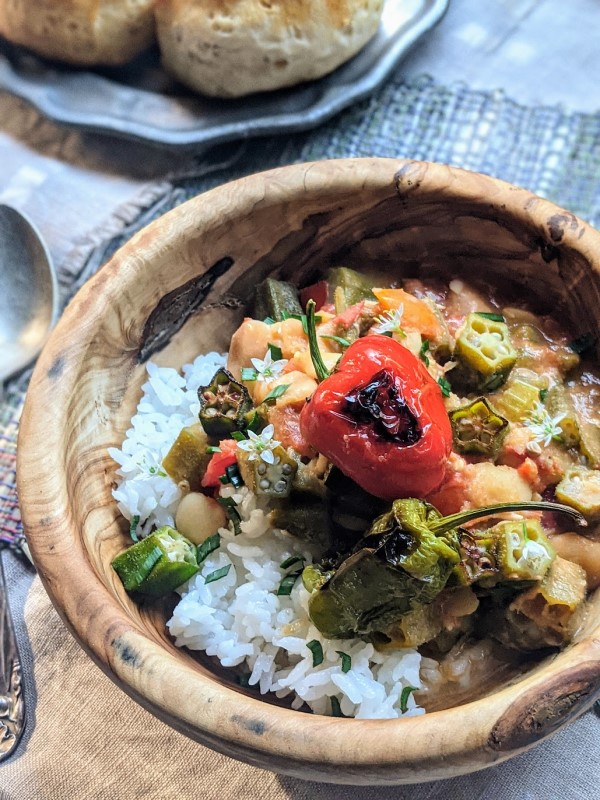Autumn Okra Stew
By Alison Steele
Moving into fall with afternoon warmth still lingering, the magic of Okra Stew is captured entirely on the stovetop. Layering the flavors of the garden in one pot along with poultry or pork, and ladling it over a steaming bowl of rice is what I think of as comfort food. I’ve chosen to celebrate the vegetables in this recipe, but where I’m from, a handful of leftover roasted chicken, a bit of chopped country ham, or peppery sausage would be a quick addition for meat lovers at the table. My grandmother would’ve used big fresh lima beans and served it up with hot biscuits and greens alongside the rice. My husband’s family, from the Chesapeake Bay region, would heap fresh blue crab on top with a dollop of sour cream topped with hot sauce. This versatile stew moved up and down the Southeast, eventually transforming into what we know as gumbo in Louisiana, with Cajun and Creole influences. Okra, along with the hot sauce that flavors it, first made its way into Lowcountry cuisine with the food culture of enslaved West Africans, who were made to work in the Carolina Gold Rice plantations. Many southern dishes have evolved this way, and are food for thought and conversation at the dinner table.
“Get two double Handfuls of young Ochra, wash and slice it thin, add two Onions chopped fine, put it into a Gallon of Water at a very early Hour in an earthen Pipkin, or very nice iron Pot; it must be kept steadily simmering, but not boiling: put in Pepper and Salt. At twelve o’clock, put in a Handful of Lima Beans; at half-past one o’Clock add three young Cimlins cleaned and cut in small Pieces, a Fowl, or a knuckle of Veal, a bit of bacon or pork that has been boiled, and six Tomatoes; when nearly done, thicken with a Spoonful of Butter, mixed with one of flour. Have rice boiled to eat with it.” – Miss Mary Randolph’s Virginia Housewife, 1831
Okra Stew serves 6
4 T butter
2 large sweet onion, diced small
¾ c sweet peppers, diced small
1 large celery rib, diced small
4 garlic cloves, minced
2 t smoked paprika
3 T flour
4 c chicken stock
4 c tomatoes, diced large
1 lb fresh okra*, destemmed and sliced in ½ inch rounds, reserve 6-8 tender pods
2 cups lima beans*
1 apple or pear, cut in half and cored
1 T hot sauce
3 t salt
½ t freshly ground black pepper
6-8 padrons or small sweet peppers, whole for garnish
Garlic chives and blossoms
Hot sauce
Traditionally served with Carolina Gold Rice*
Melt the butter in a cast iron dutch oven, or other heavy bottom soup pot. Add the onion. Cook for five minutes, stirring occasionally. Add in peppers, celery, and garlic. Cook on medium heat until soft and translucent, but not browned, another 5 minutes or so. Add in the okra, reserving the additional cup. Sprinkle paprika and freshly ground pepper, stir, and allow the spices to bloom. Stir the flour into ½ cup of stock and pour over vegetables. Stir for a few minutes to incorporate and allow the flour to cook. Next, add the tomatoes, beans, and salt. Finally, pour in the rest of the stock, add the apple or pear and cover. The fruit will balance the acidity of the tomatoes. Once the stew comes to a boil, quickly turn down the heat, and let simmer for about 30 minutes or until vegetables are soft.
While the stew is simmering, gather a handful of chives and chop fine, leaving blossoms whole. Cook the rice with stock, salt, black pepper, bay leaf, and butter. In a small cast iron skillet, dry saute the small peppers on medium high, turning until just blackened and soft. Sprinkle with a big pinch of salt, drizzle with olive oil, turn off the heat and let cook a few minutes longer while slicing the rest of the okra. Pour peppers into a bowl, and reuse the skillet, adding a drizzle of oil, a pinch of salt, and medium high heat to brown the remaining okra. Once the stew is finished, remove the fruit, scoop some hot rice into a bowl, and spoon over twice as much stew. Top with pan-roasted peppers and crispy okra. Sprinkle with garlic chives, blossoms, and a few drops of hot sauce to taste. Dig in!
A native of Virginia, Alison Steele lives with her husband, two children, and cat in Boulder Creek where she raises quail, chickens, fruit trees, vegetables, and herbs. Alison plays banjo and sings in Sugar by the Pound.
Photo by Alison Steele
The San Lorenzo Valley Post is your essential guide to life in the Santa Cruz Mountains. We're dedicated to delivering the latest news, events, and stories that matter to our community. From local government to schools, from environmental issues to the arts, we're committed to providing comprehensive and unbiased coverage. We believe in the power of community journalism and strive to be a platform for diverse voices.





